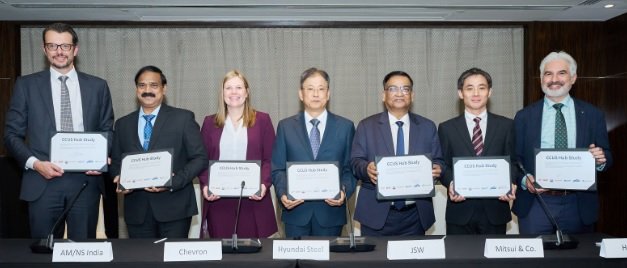Last Updated on August 12, 2025 1:02 pm by BIZNAMA NEWS
Singapore
— In a major step toward industrial decarbonisation, a consortium of leading steelmakers and energy companies — including ArcelorMittal Nippon Steel India (AM/NS India), JSW Steel, Hyundai Steel Company, BHP, Chevron, and Mitsui & Co., Ltd. — has announced a pre-feasibility study to explore the creation of large-scale Carbon Capture, Utilisation and Storage (CCUS) hubs across Asia.
The industry-led CCUS Hub Study, the first of its kind in the region, will examine both technical and commercial pathways for capturing carbon dioxide (CO₂) from hard-to-abate sectors such as steelmaking and repurposing or storing it at scale. The goal is to leverage shared infrastructure and economies of scale to lower costs, expand utilisation options, and accelerate adoption across multiple industries.
Under the plan, each participant will be linked to at least one proposed CCUS hub. The study will produce conceptual development strategies for each site, including cost and schedule estimates, commercialisation routes, and regulatory assessments — covering both domestic and cross-border CO₂ transport. The consortium is open to additional members and has appointed Hatch as Project Management Officer, working alongside the Global CCS Institute, McDaniel, and Pace CCS. Findings will be published at the end of 2026 to inform broader industry efforts and support policy development.
A push for scale and collaboration
CCUS is already proven in various industrial applications, but scaling it for regional impact remains a challenge. The consortium’s hub approach aims to aggregate captured CO₂ in sufficient volumes to:
- Optimise capture, transport, and storage costs through shared infrastructure.
- Enable economic utilisation solutions.
- Unlock decarbonisation pathways for multiple sectors at once.
- Spread cost and risk across stakeholders.
Industry voices on the initiative
Dr. Ben Ellis, Vice President Marketing Sustainability at BHP, noted that over one billion tonnes of Asia’s annual steel output comes from relatively young blast furnace capacity. “It’s critical to develop technologies to decarbonise these existing assets while long-term solutions mature,” he said, adding that shared resources and CCUS could play an “essential role” in reducing emissions from steelmaking.
Dr. Arvind Bodhankar, Chief Sustainability Officer at AM/NS India, stressed that industrial responsibility must extend beyond producing high-quality steel. “The choices we make today will shape the next generation far more than our own,” he said, describing the consortium as a platform for setting “new benchmarks” in industrial decarbonisation and strengthening India’s global competitiveness.
At JSW Group, Chief Sustainability Officer Prabodha Acharya reaffirmed the company’s target to cut CO₂ intensity in steelmaking by 42% by 2030 from 2005 levels, having already achieved a 30% reduction. He warned, however, that CCUS must become financially viable to reach net-zero emissions in steel. “Partnerships like this are essential to accelerate deployment,” he said.
Yonghee Kim, Vice President of Process R&D at Hyundai Steel, said the initiative “goes beyond conventional technological development” by aiming for measurable emissions cuts through international collaboration. Hyundai will continue to develop a range of low-carbon technologies, including CCUS, to improve industry sustainability.
From the energy sector, David Fallon, General Manager of Lower Carbon Execution at Chevron Australia, emphasised the company’s belief in CCUS’s role in cutting emissions from hard-to-abate industries. “We are leveraging our expertise and global reach to scale solutions across the value chain,” he said.
Mitsui & Co.’s Chief Operating Officer Masaya Inamuro highlighted the firm’s net-zero by 2050 goal and interim target of a 30% reduction by 2030. “This study will explore viable pathways for large-scale CO₂ reduction and lay the foundation for future decarbonisation solutions,” he said.
Next steps
The consortium’s work will run through 2026, with a focus on designing CCUS hubs that can overcome current regulatory and market barriers in Asia. By pooling resources, technology, and expertise, the partners hope to accelerate regional decarbonisation, support policy innovation, and create a replicable model for other parts of the world.

